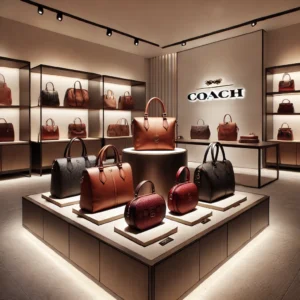Is Coach a Luxury Brand? A Deep Dive into an American Icon
Walk into any major mall in America, and you’ll find it: the gleaming storefront of Coach, its windows displaying buttery leather bags and signature C-logo canvas. For decades, Coach has been a staple in the American fashion landscape, a go-to for that first “real” handbag, a trusted travel companion, and a symbol of accessible style. But as the lines in the fashion world blur, a persistent question arises: Is Coach truly a luxury brand?
The short answer is: Coach is best classified as an “accessible luxury” or “affordable luxury” brand. It occupies a unique and powerful space between mainstream high-street brands and the top-tier European luxury houses like Hermès or Chanel. While it offers premium quality, heritage, and craftsmanship, its price point and wider availability distinguish it from the highest echelons of luxury.
But that simple answer doesn’t do justice to the brand’s incredible journey, its commitment to quality, and its current resurgence under Creative Director Stuart Vevers. To really understand Coach’s place in the fashion hierarchy, we need to unpack what “luxury” truly means in the 21st century and examine how Coach measures up. As a fashion analyst with over a decade of experience tracking brand trajectories, I’ve watched Coach’s evolution with fascination. Let’s explore the evidence together.
From a Manhattan Loft to a Global Powerhouse: The Coach Story
You can’t talk about Coach without talking about its history. Founded in 1941 in a Manhattan loft as a family-run workshop, its origins are humble. The six artisans who started the company were inspired by the soft, supple feel of a worn baseball glove. They sought to replicate that durable, patina-rich leather for handbags—an innovation that would define the brand for generations.
This was the era of Bonnie Cashin, the legendary designer who, in the 1960s, revolutionized the brand. She introduced the iconic turn-lock clasp, vibrant colors, and the idea of functional, stylish bags for the modern woman. This wasn’t just about creating a pretty accessory; it was about American pragmatism meeting chic design. That heritage of quality and practicality is the bedrock of Coach’s brand identity.
However, the late 90s and early 2000s saw a shift. The brand exploded in popularity, and with that came over-exposure. The signature “C” logo became ubiquitous, often seen on outlet-exclusive products, which diluted its premium feel. For a time, Coach lost some of its luster. But the story doesn’t end there. In 2013, the appointment of Stuart Vevers marked a turning point, initiating a successful rebranding that refocused on leather craftsmanship, introduced ready-to-wear collections, and injected a youthful, cool-kid energy that has resonated with a new generation.
Defining “Luxury”: What Are the Metrics?
Before we can place Coach, we must agree on a definition. True luxury is typically defined by a combination of factors:
- Exceptional Craftsmanship & Materials: Use of the finest materials, with meticulous attention to detail and hand-finishing.
- Rich Heritage & Storytelling: A long, authentic history that adds to the brand’s mystique.
- Exclusivity & Scarcity: Limited production, controlled distribution, and a sense of being hard to obtain.
- Premium Price Point: A high price that reflects the quality, craftsmanship, and brand value.
- Timeless Design & Brand Prestige: A strong, recognizable aesthetic that transcends fleeting trends.
So, how does Coach score on these points?
Craftsmanship & Materials: A Solid A-
This is where Coach truly shines and stakes its claim to luxury. The brand’s signature glovetanned leather is exceptional for its price point. It’s durable, soft, and develops a beautiful patina over time, much like the baseball gloves that inspired it. I’ve personally owned a Coach Dinky bag for over seven years, and the leather has only gotten better with age, a true testament to its quality. The stitching is consistently clean, and the hardware is substantial and built to last. While it may not use the same impossibly rare leathers as a brand like Hermès, its commitment to quality materials is undeniable.

Expert’s Pick: The Coach Tabby Shoulder Bag
The Tabby represents the perfect fusion of Coach’s heritage and modern style. Featuring the iconic “C” hardware and crafted from a mix of polished pebble leather and refined calf leather, it’s a masterclass in accessible luxury. It’s structured, versatile, and feels substantial—a bag that elevates any outfit without the eye-watering price tag of European counterparts.
Check Price on AmazonHeritage & Storytelling: A Strong A
With over 80 years of history, Coach is a quintessential American story. It has a rich narrative rooted in New York City, innovation (the baseball glove leather), and iconic design leadership (Bonnie Cashin). This history gives the brand an authenticity that newer contemporary brands lack. It has earned its place in the fashion history books.
Exclusivity & Scarcity: A C+
This is the primary area where Coach diverges from traditional luxury. Luxury thrives on being hard to get. Coach, by contrast, is widely available. You can find it in dedicated boutiques, department stores, and, notably, a large network of outlet stores. This accessibility is a core part of its business model, but it inherently reduces the sense of exclusivity. A Chanel Classic Flap feels exclusive because you can only buy it from a Chanel boutique, often after being on a waitlist. A Coach bag can be purchased with relative ease. This isn’t a flaw in its strategy; it’s a deliberate choice to cater to a broader audience.
This strategy places Coach in a similar category to brands that balance prestige with accessibility. For instance, the discussion around “Is Longchamp a luxury brand?” often highlights a similar dynamic: a brand celebrated for quality and heritage but available at a more democratic price point and in more locations than, say, a Goyard.
Price Point: The “Accessible Luxury” Sweet Spot
A typical Coach handbag might range from $250 to $700. A special edition or runway piece might climb higher, but the core collection sits firmly in this range. Compare this to a Gucci or Prada bag, which starts around $2,000 and goes up quickly, or a Chanel bag, which can easily exceed $10,000. Coach is undeniably a premium product, far more expensive than a fast-fashion handbag, but it’s not in the same financial stratosphere as high luxury.
This pricing strategy is brilliant. It makes a luxury *feeling* attainable for a professional milestone, a special birthday, or a well-deserved treat. It’s a “first step” into the world of premium goods. This also sets it apart from other contemporary brands. While you might wonder “Is Karl Lagerfeld a luxury brand?” or ponder if Armani Exchange qualifies, Coach generally commands a higher price and is perceived as a step above due to its stronger focus on leather goods and its American heritage. It occupies a more established position than many diffusion lines like Armani Exchange, which is explicitly a more accessible brand within the Armani ecosystem.
Key Takeaways: Coach’s Market Position
- Accessible Luxury: Sits between high-street brands and top-tier luxury.
- Quality Focus: Known for durable, high-quality leather and craftsmanship.
- Heritage Brand: Boasts an 80+ year history rooted in New York.
- Wide Availability: Sold through boutiques, department stores, and outlets, reducing exclusivity.
- Mid-Tier Pricing: Premium price but significantly lower than European luxury houses.
The Modern Coach: Cool, Confident, and Culturally Relevant
Under Stuart Vevers, Coach has become cool again. Collaborations with celebrities like Jennifer Lopez and Lil Nas X, along with a focus on Gen Z-friendly designs like the Pillow Tabby, have made the brand incredibly relevant. The brand’s runway shows are now major events, and its ready-to-wear collections receive critical acclaim. This modern-day cultural capital is crucial. A luxury brand can’t just rely on its history; it must be part of the current conversation.
Think of it like the automotive world. You have ultra-luxury brands like Rolls-Royce, and then you have brands that offer a premium, near-luxury experience at a more attainable price. The conversation around whether Genesis is a luxury car mirrors this debate perfectly. Genesis provides exceptional quality, design, and features that rival established luxury players, but at a more accessible price point, carving out its own space. Coach does the same in the fashion world.

Editor’s Recommendation: The Coach Willow Tote
For the professional who needs style and function, the Willow Tote is a home run. Made from polished pebble leather, it’s deceptively spacious with a well-organized interior, including a central zip compartment. It’s the kind of timeless, practical, and elegant bag that showcases what Coach does best: making high-quality, aspirational products for real life.
Find It On AmazonThe Verdict: Is Coach a Luxury Brand?
After weighing all the evidence, my expert conclusion is this: Coach is a bona fide luxury brand, but it operates within the specific, and highly successful, category of “accessible luxury.”
To deny it luxury status would be to ignore its rich heritage, its demonstrable commitment to high-quality leather and craftsmanship, and its powerful brand identity. It provides a genuine luxury experience in terms of product quality and brand story. However, its business strategy—built on broader accessibility and a more attainable price point—differentiates it from the highly exclusive, top-tier European houses.
And that’s perfectly okay. Coach isn’t trying to be Hermès. It’s trying to be the best version of Coach—an American icon that offers timeless style and exceptional quality that you don’t have to mortgage your house for. It’s a brand that can be a young person’s first major fashion investment and a lifelong staple in a discerning adult’s wardrobe. In the modern, democratized world of fashion, Coach has carved out an enviable and enduring niche. It is, without a doubt, a symbol of American luxury.
Frequently Asked Questions (FAQs)
Is Coach better quality than Michael Kors or Kate Spade?
Generally, fashion experts and consumers agree that Coach’s leather quality and hardware durability are a step above those of Michael Kors and Kate Spade, particularly in their core retail collections (not outlet-specific lines). While all three are competitors in the accessible luxury space, Coach’s long history as a leather goods company often gives it an edge in craftsmanship.
Do Coach bags hold their value?
While Coach bags don’t have the same investment-level resale value as a Chanel or Hermès, certain vintage or popular modern styles (like the Tabby) can hold their value quite well on the secondhand market. A classic, well-maintained leather Coach bag is not a “disposable” item; it’s a durable good that can last for decades, and its value retention is better than most mainstream brands.
What is the difference between Coach retail and Coach outlet products?
This is a crucial distinction. Coach retail boutiques carry the main collection, which is made with the highest quality materials and craftsmanship. Coach Outlet stores primarily sell products made specifically for the outlet channel (“Made-for-Factory” or MFF items). While still good quality, MFF products may use slightly different materials, simplified hardware, or different construction methods to achieve a lower price point. For the best representation of Coach’s luxury quality, it’s best to look at their retail offerings.


